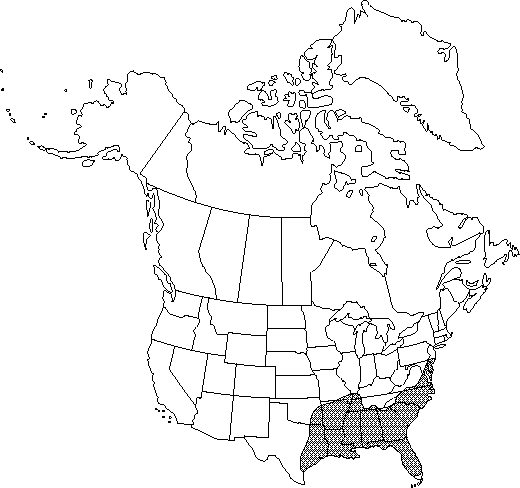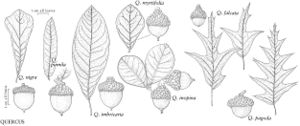Difference between revisions of "Quercus nigra"
Sp. Pl. 2: 995. 1753.
FNA>Volume Importer |
imported>Volume Importer |
||
| (5 intermediate revisions by 2 users not shown) | |||
| Line 9: | Line 9: | ||
|common_names=Water oak;chêne gris | |common_names=Water oak;chêne gris | ||
|special_status={{Treatment/ID/Special_status | |special_status={{Treatment/ID/Special_status | ||
| + | |code=W1 | ||
| + | |label= | ||
| + | }}{{Treatment/ID/Special_status | ||
|code=E | |code=E | ||
|label=Endemic | |label=Endemic | ||
}}{{Treatment/ID/Special_status | }}{{Treatment/ID/Special_status | ||
|code=F | |code=F | ||
| − | |label= | + | |label=Illustrated |
| − | |||
| − | |||
| − | |||
}} | }} | ||
|basionyms= | |basionyms= | ||
| Line 22: | Line 22: | ||
|name=Quercus nana | |name=Quercus nana | ||
|authority=Willdenow | |authority=Willdenow | ||
| + | |rank=species | ||
}} {{Treatment/ID/Synonym | }} {{Treatment/ID/Synonym | ||
|name=Quercus nigra var. tridentifera | |name=Quercus nigra var. tridentifera | ||
|authority=Sargent | |authority=Sargent | ||
| + | |rank=variety | ||
}} {{Treatment/ID/Synonym | }} {{Treatment/ID/Synonym | ||
|name=Quercus uliginosa | |name=Quercus uliginosa | ||
| − | |authority= | + | |authority= |
| + | |rank=species | ||
}} | }} | ||
|hierarchy=Fagaceae;Quercus;Quercus sect. Lobatae;Quercus nigra | |hierarchy=Fagaceae;Quercus;Quercus sect. Lobatae;Quercus nigra | ||
| Line 54: | Line 57: | ||
-->{{#Taxon: | -->{{#Taxon: | ||
name=Quercus nigra | name=Quercus nigra | ||
| − | |||
|authority=Linnaeus | |authority=Linnaeus | ||
|rank=species | |rank=species | ||
| Line 68: | Line 70: | ||
|publication title=Sp. Pl. | |publication title=Sp. Pl. | ||
|publication year=1753 | |publication year=1753 | ||
| − | |special status=Endemic; | + | |special status=W1;Endemic;Illustrated |
| − | |source xml=https:// | + | |source xml=https://bitbucket.org/aafc-mbb/fna-data-curation/src/2e0870ddd59836b60bcf96646a41e87ea5a5943a/coarse_grained_fna_xml/V3/V3_388.xml |
|genus=Quercus | |genus=Quercus | ||
|section=Quercus sect. Lobatae | |section=Quercus sect. Lobatae | ||
Latest revision as of 21:48, 5 November 2020
Trees, deciduous or tardily deciduous, to 30 m. Bark grayish black, fissures irregular, shallow, inner bark pinkish. Twigs dark red-brown, 1.5-2.5 mm diam., glabrous. Terminal buds reddish brown, ovoid, 3-6.5 mm, puberulent throughout, occasionally densely pubescent on apical 2/3. Leaves: petiole 2-9 mm, glabrous. Leaf blade distinctly obtrullate, rarely elliptic or merely obovate, widest near apex, 30-120(-160) × 15-60(-70) mm, base attenuate or cuneate, rarely rounded, margins entire with 1 apical awn or with 2-3 shallow lobes and 2-5 awns (leaves on juvenile or 2d-flush growth may be deeply lobed with more awns), apex obtuse to blunt or rounded; surfaces abaxially glabrous except for minute or conspicuous axillary tufts of tomentum, veins rarely raised, adaxially glabrous with secondary veins somewhat impressed. Acorns biennial; cup saucer-shaped, 2.5-5.5 mm high × 10-18 mm wide, covering 1/4 nut or less, outer surface puberulent, inner surface sparsely to uniformly pubescent, scale tips tightly appressed, acute; nut broadly ovoid, 9.5-14 × 9.5-14.5 mm, often faintly striate, glabrate, scar diam. 6-11.5 mm.
Phenology: Flowering spring.
Habitat: Mesic alluvial and lowland sites, also barrens, dunes, hammocks, and low ridges to steep slopes
Elevation: 0-450 m
Distribution

Ala., Ark., Del., Fla., Ga., Ky., La., Md., Miss., Mo., N.J., N.C., Okla., S.C., Tenn., Tex., Va.
Discussion
Typically on mesic alluvial and lowland sites, Quercus nigra also occurs on a wide variety of soil types and in a diversity of habitats.
Trees with 3-lobed leaves with attenuate bases have been recognized as Quercus nigra var. tridentifera Sargent.
Quercus nigra reportedly hybridizes with Q. falcata (= Q. ×garlandensis E. J. Palmer), Q. incana, Q. laevis (= Q. ×walteriana Ashe), Q. marilandica (= Q. ×sterilis Trelease), Q. phellos (= Q. ×capesii W. Wolf), Q. shumardii (= Q. ×neopalmeri Sudworth), and Q. velutina (Q. ×demarei Ashe). In addition, D. M. Hunt (1989) cited evidence of hybridization also with Q. arkansana, Q. georgiana, Q. hemisphaerica, Q. laurifolia, Q. myrtifolia, Q. palustris, Q. rubra, and Q. texana.
Selected References
None.
